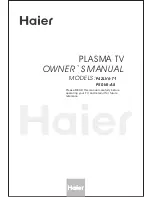
Connections and Setup
18
Chapter
1
Explanation of Jacks (in alphabetical order)
This section describes the jacks on the back panel of your TV. There are several ways to
connect devices.
ANTENNA/CABLE ANALOG INPUT
Lets you connect a coaxial cable to receive the signal
from the antenna, cable, or cable box.
ANTENNA/CABLE DIGITAL INPUT
Lets you connect a coaxial cable to receive the signal
from the antenna.
COMPONENT INPUTS
Lets you connect a device that has component video jacks, such as a
DVD player.
•
CMP1 Y Pb/Cb Pr/Cr (Component Video)
Provides optimum picture quality because the
video is separated into three signals. Use three video-grade or component video cables for
the connection. When using CMP1 Y Pb/Cb Pr/Cr, make sure you connect left and right
audio cables to the CMP1 L and R AUDIO jacks.
•
CMP1 L AUDIO
Provides left audio connection when using the CMP1 video inputs. The left
audio connector is usually white.
•
CMP1 R AUDIO
Provides right audio connection when using the CMP1 video inputs. The
right audio connector is usually red.
•
CMP2 Y Pb/Cb Pr/Cr (Component Video)
Same as described for CMP1 Y Pb/Cb Pr/Cr and
CMP1 Audio above
.
Make sure you connect the left and right audio cables to the CMP2 L
and R AUDIO jacks.
HDMI/DVI Input
Lets you connect a device, such as a digital cable box, with an HDMI or a
DVI output.
•
HDMI/DVI INPUT
(High-Defi nition Multimedia Interface/Digital Visual
Interface) Provides an uncompressed digital connection that carries both video and audio
data by way of an integrated mini-plug cable. Since HDMI technology is based on Digital
Visual Interface (DVI), the jack on the back of your TV is also compatible with DVI devices.
•
L AUDIO (used for DVI only)
Provides left audio connection when using the DVI jack. The
left audio connector is usually white.
•
R AUDIO (used for DVI only)
Provides right audio connection when using the DVI jack.
The right audio connector is usually red.
Note:
If using HDMI/DVI as a DVI connection, remember to connect the left and right
audio cables because the DVI cable carries only the picture signal, not the sound.
MONITOR OUT
Connect a VCR or DVD-recorder to record digital and analog programs
(excluding copy-protected programs and component video formats) while the TV is turned on.
You must leave the TV on the same channel you are recording.
AUDIO
Use the Audio Out jacks when using the MONITOR OUTPUT Video jack or use these
jacks by themselves to connect an audio receiver to the TV for enhanced sound quality. If you
use these jacks to receive your sound, you don't need to connect the speakers supplied with
the TV. Make sure you set the Audio output correctly in the
Advanced Settings Sound
menu. Go
to page 36 for more information.
•
L (Audio)
Provides left audio connection. The left audio connector is usually white.
•
R (Audio)
Provides right audio connection. The right audio connector is usually red.
Book 1.indb 18
Book 1.indb 18
3/3/06 12:23:49 PM
3/3/06 12:23:49 PM












































